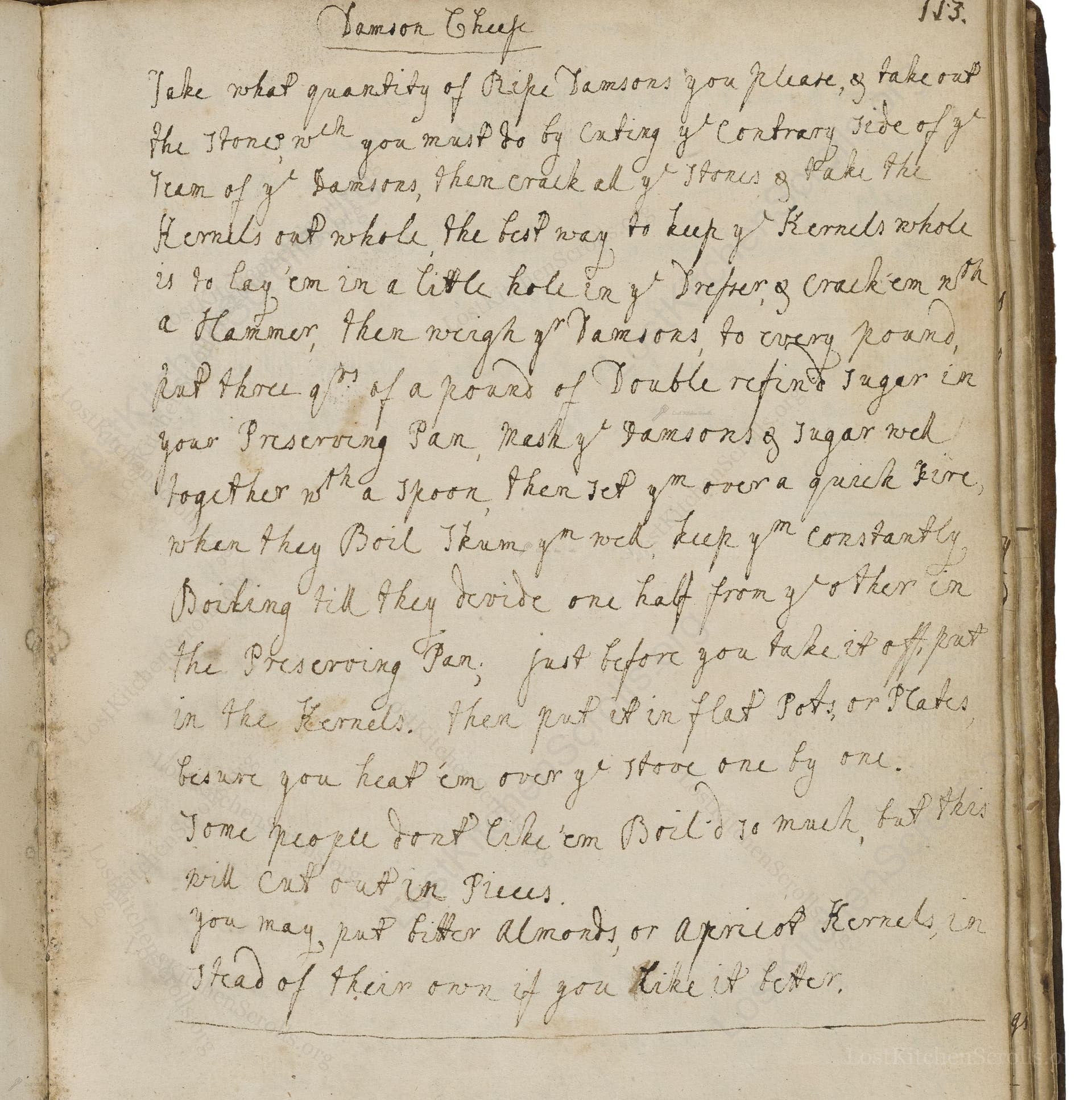Damson Cheefe
From the treasured pages of Receipt book of Elizabeth Smith
Written by Elizabeth Smith

Damson Cheefe
"Take what quantity of Ripe Damsons you please, & take out the Stones wch you must do by Cuting ye Contrary side of ye Team of ye Damsons, then crack all ye Stones & take the Kernels out whole the best way to keep ye Kernels whole is to lay 'em in a little hole & in ye Pressing Crack 'em wth a Hammer, then weigh ye Damsons to every Pound, put three qrs of a pound of Double refin'd Sugar in your Preserving Pan, mesh ym Together wth a Spoon Then set ym over a quick Fire, wth ye Sugar wch when they Boil Them ym well, keep ym constantly Boiling till they devide one half from ye other in the Preserving Pan, just before you take it off, put in the Kernels. Then put it in flat Pots, or Plates, take care you heat 'em over ye Stove one by one. Some people dont like 'em Boild so much, but they will Cutt out in Pieces. You may put bitter Almonds, or apricot Kernels, in Stead of their own if you like it better."
Note on the Original Text
The recipe uses a conversational tone and abbreviations typical of the late 18th century, with archaic spellings like 'ye' for 'the', and 'ym' for 'them'. Instructions are continuous, with little separation of steps, assuming a baseline familiarity with preserving. Specific measurements ('Pound', 'three qrs') reflect the proportional approach of historical cooking. The recipe reflects careful utilization of the whole fruit, characteristic of its era.

Title
Receipt book of Elizabeth Smith (1775)
You can also click the book image above to peruse the original tome
Writer
Elizabeth Smith
Era
1775
Publisher
Unknown
Background
Step into the refined kitchens of the late 18th century with Elizabeth Smith, whose culinary wisdom offers a charming taste of Georgian elegance and time-honored recipes to delight any palate.
Kindly made available by
Folger Shakespeare Library
This recipe comes from Elizabeth Smith, who flourished between 1749 and 1800, an era when fruit preserving was a crucial method of storing seasonal abundance. Damson 'cheese' refers not to dairy, but to a dense, sliceable fruit preserve that was both a delicacy and a staple, served at English tables with meats, breads, and desserts alike. Such recipes exhibit both ingenuity and the resourceful spirit of early modern cooks—including the use of fruit kernels for flavor and texture.

In the 18th century, cooks would have used a paring knife to stone the fruit, a mortar and pestle or a hammer to crack the stones, a large preserving pan (typically copper or brass), and a strong spoon to mash and stir. Shallow earthenware or pottery dishes, gently warmed by the hearth or stove, were used to set and store the damson cheese. Preserving was done over an open fire or a strong coal or wood stove.
Prep Time
20 mins
Cook Time
40 mins
Servings
10
We've done our best to adapt this historical recipe for modern kitchens, but some details may still need refinement. We warmly welcome feedback from fellow cooks and culinary historians — your insights support the entire community!
Ingredients
- 2.2 lb ripe damsons (or plums as a substitute)
- 1 lb 10½ oz white granulated sugar
- 20-30 damson kernels (or substitute with 10-15 bitter almonds or apricot kernels)
- Optional: additional bitter almonds or apricot kernels to taste
Instructions
- To make Damson Cheese in a modern kitchen, start by weighing your ripe damsons, planning roughly 2.2 lb of fruit.
- Slice each damson along its seam and remove the stones.
- Carefully crack the stones with a hammer to extract the kernels whole—if you prefer, you can substitute with bitter almonds or apricot kernels.
- For every 2.2 lb of damsons, use 1 lb 10½ oz of white granulated sugar (double refined).
- Combine the pitted damsons and sugar in a heavy saucepan and mash well.
- Set over medium-high heat and bring to a boil, stirring to prevent sticking.
- Continue to boil vigorously, frequently stirring and mashing, until the mixture thickens and reduces by about half; this may take 30-40 minutes.
- Just before finishing, add the reserved kernels or substituted nuts.
- Pour the thick puree into warmed shallow dishes or trays—warming prevents thermal shock and cracking.
- Let cool and set, then cut into pieces to serve.
Estimated Calories
200 per serving
Cooking Estimates
It takes about 20 minutes to prepare the damsons and kernels, and about 40 minutes to cook the cheese. Each serving contains roughly 200 calories, and you get 10 servings from this recipe.
As noted above, we have made our best effort to translate and adapt this historical recipe for modern kitchens, taking into account ingredients nowadays, cooking techniques, measurements, and so on. However, historical recipes often contain assumptions that require interpretation.
We'd love for anyone to help improve these adaptations. Community contributions are highly welcome. If you have suggestions, corrections, or cooking tips based on your experience with this recipe, please share them below.
Join the Discussion
Rate This Recipe
Dietary Preference
Main Ingredients
Culinary Technique

Den Bockfisch In Einer Fleisch Suppen Zu Kochen
This recipe hails from a German manuscript cookbook compiled in 1696, a time whe...

Die Grieß Nudlen Zumachen
This recipe comes from a rather mysterious manuscript cookbook, penned anonymous...

Ein Boudain
This recipe comes from an anonymous German-language manuscript cookbook from 169...

Ein Gesaltzen Citroni
This recipe, dating from 1696, comes from an extensive anonymous German cookbook...
Browse our complete collection of time-honored recipes



